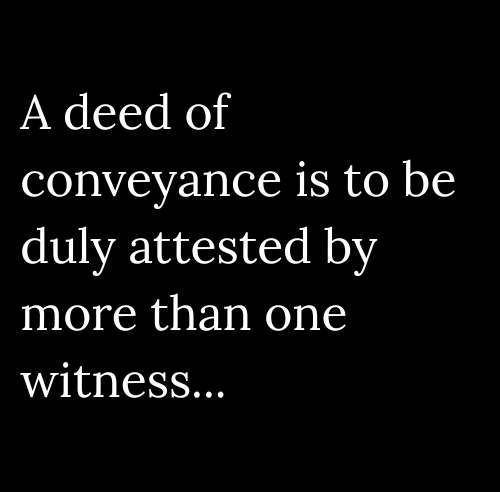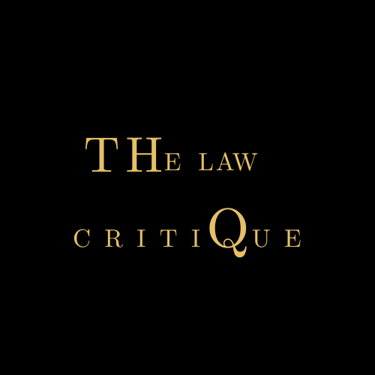attestation of a deed, "animo attestandi"
a deed is to be duly attested by more than one witness, what is attestation and what are the important prerequisites of a valid attestion
THelawcritiQue
6/4/20254 min read


An instrument needs to be duly ‘Attested’.. what confers valid attestation, with reference to Interpretation Clause: Section 3 – Transfer of Property Act, 1882. ---
In general, the execution of any document is confirmed by two witnesses attesting at the end of the document. The attention confirms the authenticity of the execution of the document by the executor himself and acts as an estoppel against the party contesting execution of the instrument. The definition of the term attested in explained under Section 3 of the Transfer of Property Act as follows,
Attested. --- "attested", in relation to an instrument, means and shall be deemed always to have meant attested by two or more witnesses each of whom has seen the executant sign or affix his mark to the instrument, or has seen some other person sign the instrument in the presence and by the direction of the executant, or has received from the executant a personal acknowledgement of his signature or mark, or of the signature of such other person, and each of whom has signed the instrument in the presence of the executant; but it shall not be necessary that more than one of such witnesses shall have been present at the same time, and no particular form of attestation shall be necessary;
The ingredients of a valid attestation can be explained as hereunder :-
(i) two or more witnesses.-- for an instrument executed under the transfer of property act be duly attested, the minimum number of persons needed to be attesting the deed is two persons. There can be any number of attestors maximum, but the minimum is two.
(ii) each of such witness has seen the executant sign or affix his mark; or some other person sign in the presence and in direction of the executant; or such witness have received personal acknowledge of the signature or mark from the executant; or of the signature of such other person
(iii) one of such signed in the presence of the accused. -- it is however mandatory that at least one of those two attesting witnesses, the one of them signed in the presence of the executor
(iv) shall not be necessary that more than one of such witnesses shall have been present at the same time. -- it is however not mandatory that both the witnesses need to be present at the same time to attest an instrument when it can be sufficiently shown that the 2nd witness signed the instrument. In an instance where the document was scribed on 1st of May and the executor signed the document on the same day and one of the attestors signed the document immediately after the executor. Later the executor brought the document to the 2nd attestor on another day, and he attested the same after knowing that the executor and 1st attestor signed the document, such case has to be considered as a valid attestation.
These are the ingredients of a valid attestation as mentioned in the definition of the attested under section 3 of the Transfer of Property Act, 1882. There are also other factors which are needed to be considered to determine whether it is a valid attestation. They are as follows:
1. under no circumstances, an attestation prior to the signature of the executant can be validated. The concept of the attestation itself is for the purpose of the proof of execution of the document. Hence without a valid execution of the document by the executor, the attestation itself shall not attain any validity. In Sant Lal Mahtan vs. Kamala Prasad, (1951), the Supreme Court held that an attestation made on 08-04-1927 where the document was originally signed by the executant on 12-04-1927, is not a valid attestation.
2. capacity of the attesting witness. --- an attesting witness shall be a person legally entitled to enter into a contract and he should be someone who can voluntarily bind himself in a valid contract. A witness might also be an illiterate putting his thumb mark on the deed, but a minor is not a valid person to attest a deed as he cannot bind himself in a legal contract. The intention of the person attesting the deed is important while considering the validity of the attestation. That means a witness whether educated or uneducated, if the witness attests the deed with the intention to attest the deed, it is a valid attestation.
animo attestandi. --- the phrase animo attestandi means “with the intention to attest the deed”. That means the attesting witness must sign or put his thumb voluntarily to certify the execution of the same. The witness should sign with an intention to act as an attesting witness to the deed. The Supreme Court emphasized in Kumar Harish Chandra Singh Deo vs. Bansidhar Mohanty (AIR 1965 SC 1738), that for attestation to be legal, “it is essential that the witness puts his signature animo attestandi -- that is with the intention of attesting.” Also in Girja Datt Singh v. Gangotri Datt Singh, AIR 1955 SC 346, it was held as “there is no attestation unless the witness has signed the document animo attestandi that is, for the purpose of testifying to the execution of the document.”
3. attestation in the case of a pardanashin lady. --- the problem arises in the case of a pardanashin woman who are not seen out side and the outsiders are not allowed to see her. How a deed executed by such woman can be attested is explained by the phrase in the section, - “or has received from the executant a personal acknowledgment of his signature or mark…”. That means that such an attesting witness even though did not actually see the executant sign the deed, must receive the personal acknowledgment of her signature. The Privy Council held in a case where the pardanashin woman put her hand out to lay her thumb which was seen by the witnesses and thereby the witnesses signed the deed, was held as a valid attestation in Lala Kundan Lal v. Musammat Mushrafi Begum (1936). Whereas in Rao Ganga Parshad Singh v. Isturi Pershad Singh’s case, where the deed was signed by the pardanashin lady behind the parda and her son stated to the attesting witnesses that it was his mother’s signature, The Privy Council held the same as not valid attestation as the witnesses actually did not see the woman sign and also did not receive the personal acknowledgement from her acknowledging her signature.
Conclusion:
The attestation is a necessary to confirm the valid and proper execution of the document or deed. Though a deed was duly attested, if does not prove the validity of the deed as an attesting witness need not know the contents of the deed. An attestation is only for the proper execution and not to prove the validity of the deed.
Connect With Us Through
Connect with us
© 2025. All rights reserved.
